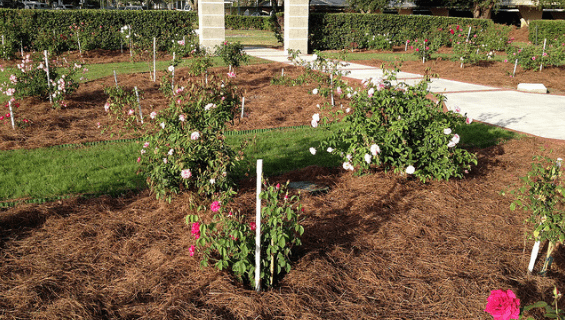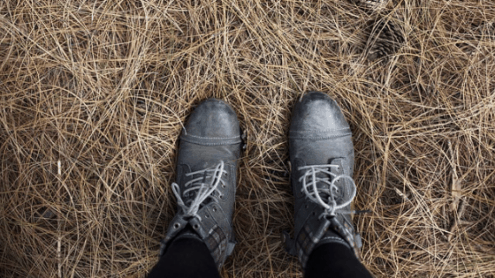If you are looking to spruce up your landscaping beds in the spring, mulch or pine straw are likely on your short list for ground coverings. Let’s take a look at mulch vs pine straw to determine the difference (if any), so that you can find the best material for your landscape beds.
Table of Contents
What is Mulch?
Mulch is a material that is placed on the landscape bed surface as a covering for the soil. It helps enrich the soil, deter weeds, retain moisture, keep the soil cool or insulated, and protects roots. Pine straw, therefore, is a type of mulch.
The common types of mulch include the following:
- Bark
- Wood Chips
- Shredded Wood
- Straw (including pine straw)
- Shredded Leaves
- Stones
- Cocoa Bean Hulls
- Rubber
What is Pine Straw?

Pine straw is the pine needles that have naturally shed from pine trees. These needles are collected and sold to customers to add as mulch to their landscaping beds.
Pine straw is a popular mulch in the Southern United States where the needles are commonly harvested for sale. Since the needles are typically collected after they fall off the pine tree, there is no disturbance to the tree.
Pine Straw Benefits
Pine straw, like other mulches, provides a protective soil barrier to help keep the dirt cool when the heat blasts and warm when the frost rolls in. This barrier also shields the soil to prevent weed growth.
Another major benefits of this type of mulch is that the needles lock together. The intertwined needles essentially create a mat across the landscape that stays in place. This makes it difficult for them to be swept away by the elements.
The needles are extremely lightweight as likely expected. Putting down pine straw is a breeze compared to the often laborious task of hauling loads of wood mulch, for example, to various landscape areas of the yard.
Pine straw will gradually decay and enrich the soil with nutrients such as calcium, nitrogen and phosphorus. Additionally, the semi-decaying straw will help retain moisture and prevent erosion.
Pine Straw: The Cons
While pine straw has the benefit of being lightweight, you will be dealing with pine needles that can be sharp. You will need to be careful during installation or potentially when weeding (if needed). Wearing gloves when handling or working around pine straw is recommended.
Pine straw is flammable. If you live in a fire prone area, you may want to consider fire-resistant ground cover or a less combustible mulch. Check out this research from the University of Nevada, which shows the results of the combustibility of landscape mulches. Shredded rubber, pine needles, and shredded western red cedar were the most hazardous in the study. Composted wood chips did the best.
Pine straw tends to break down much quicker than many other types of mulch. You will have to replenish or replace it more often. While pine straw can be much cheaper than wood mulches, for example, the need to replenish the pine straw more often does not make it an overwhelming value buy.
One complaint that we hear is that pine straw mulch does not completely deter weeds. While this may be true, you will also find weeds in other types of mulch as well. The best way to deter weeds is to place a weed barrier fabric down before the mulch. Furthermore, the mulch layer should be thick enough to block sunlight. More on the thickness of pine straw below.
Pine Straw: Q & A
While pine needles on the tree are acidic, they move toward neutral once they fall from the tree and sit on the ground for a few days. The idea that pine straw will change the pH of garden soil is a myth.
Is pine straw a fire hazard?
Yes, see the pine straw cons section above.
Pine straw is typically sold in bails tied with twine. There is not a plastic bag to dispose of like many other mulch products you buy at a local home centers. Pine straw is simply collected from the ground once the pine trees shed their needles. Pine trees are not injure during the collection process. They will be relied upon for additional pine straw harvests in future years.
Pine straw are the pine needles that have been shed from the pine tree. Pine straw is commonly a reddish brown color unlike the green color of pine needles.
3 to 4 inches is thick enough to help prevent weeds and provide the additional benefits of pine straw discussed above. Keep in mind that this thickness may not be practical for some landscape areas with short plants.
When to lay pine straw?
Early Spring (before bulbs bloom) and fall are the two common times to lay pine straw. However, anytime the straw needs to be replenished is suitable. We recommend waiting in the fall until after the leaves have been cleaned up to lay pine straw.
Annual replacement is recommended with a clean out of the old mulch to prevent insects/vermin and to prevent weed growth. A bi-annual application may be desired by some to maintain a fresh look for the landscape.
Please take a look at this video, which guides you through the process.
This is a personal preference. There are many people who prefer pine straw and many who favor wood mulch.

